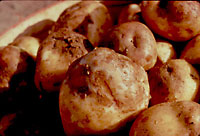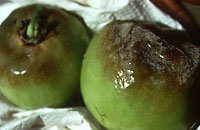Protocol: Cellulose acetate electrophoresis (CAE)
1. The starting material may be a sporulating lesion or a sporulating Phytophthora infestans culture.
A. If you have a sporulating lesion, place the lesion in an Eppendorf tube with 1 ml of dH20. Vortex the sample to release the sporangia into the water, and remove the lesion. Spin the tube on high in a microfuge for 3 minutes to pellet the sporangia. Then pour off all of the liquid except for one drop. Proceed to step 2.
B. If you have a sporulating culture, using a scalpel, place a small amount of sporulating mycelium in an Eppendorf tube containing 2-3 drops of dH20. Proceed to step 2.
2. Using a homogenizer attached to an electric drill, grind the samples for 30-60 seconds in order to break apart the sporangia. Spray the homogenizer with dH20 and wipe down with a Kimwipe between samples.
3. Pipette 8-10 ul of each sample in a different well of the sample well plate. On a separate sheet of paper, note which sample was placed in each well.
4. Blot a cellulose acetate plate, which has been soaking in buffer solution, between two pieces of Whatman paper. Then align it on the aligning base cellulose acetate side up.
5. Align the applicator with the sample well plate, and press down several times in order to pick up some of each sample on the applicator. Then align the applicator on the aligning base, and press down 2-3 times in order to transfer the material from the applicator to the plate. Repeat this entire process 2-3 times.
6. Place a small amount of a running dye, usually food coloring, to spot one side of the gel to monitor the electrophoresis.
7. Place the plate cellulose acetate side down in the gel box (containing buffer solution) such that the plate is in good contact with the 2 wicks and the wells are closest to the – side of the chamber.
8. Run the electrophoresis for 18-20 minutes at 200 V.
9. About 5 minutes from the end of the electrophoresis, prepare the following.
A. Make a 1.6% agar solution (160 mg/ml).
B. Combine the following for each gel. Wear gloves!!!!!!
Tris-HCl, 0.05 M, pH 8.0 1.5 ml
Fructose-6-phosphate, 20 mg/ml 5 drops
NAD, 3 mg/ml 1.0 ml
MTT, 10 mg/ml 5 drops
PMS, 2 mg/ml 5 drops
10. When the electrophoresis is over, place the plate face-up on a glass plate. Then add the following to the solution made in 9B.
Agar, 1.6%, 60oC 2.0 ml
G-6-PDH, 1 U/ul 3.0 ul
11. Pour this solution over the plate and allow the reaction to take place. Eventually, bands will become visible on the gel. Once the bands have fully developed, the solution may be washed off using dH20, and the plate may be photographed.


